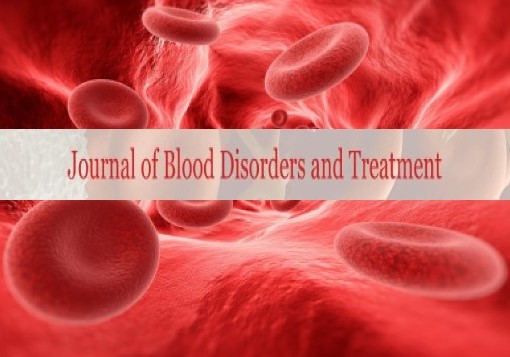Blood Disorder: Sickle Cell Disease
N e w D e l h i
, India,Received: 05-Mar-2021 Accepted Date: Mar 18, 2021; Published: 25-Mar-2021
Citation: Erigeshi A. Blood Disorder: Sickle Cell Disease. J Blood Disord Treat.2021;4(2):4.
This open-access article is distributed under the terms of the Creative Commons Attribution Non-Commercial License (CC BY-NC) (http://creativecommons.org/licenses/by-nc/4.0/), which permits reuse, distribution and reproduction of the article, provided that the original work is properly cited and the reuse is restricted to noncommercial purposes. For commercial reuse, contact reprints@pulsus.com
Abstract
Sickle cell disease (SCD) may be a persistent sickness, and the major complication, torment, comes about in complex multidimensional problems that influence an individual's capacity to preserve satisfactory quality of life in multiple ranges. Constant SCD torment is insufficiently treated, since it isn't well caught on, and the degree of incessant torment, clinical introduction, and sequela complications can change from persistent to understanding, indeed among people with the same SCD genotype. The reason for this variety is obscure, but the basic cause may be hereditary.
Introduction
Sickle cell illness may be a gather of blood disorders typically acquired from a person's guardians. The foremost common sort is known as sickle cell weakness. It comes about in an variation from the norm within the oxygencarrying protein hemoglobin found in red blood cells.
Sickle cell malady happens when a individual acquires two unusual duplicates of the β-globin quality (HBB) that creates hemoglobin, one from each parent. This quality happens in chromosome 11. Several subtypes exist, depending on the precise change in each hemoglobin gene. An assault can be set off by temperature changes, stretch, parchedness, and tall altitude. A individual with a single anomalous duplicate does not as a rule have indications and is said to have sickle cell trait. Such individuals are moreover alluded to as carriers. Conclusion is by a blood test, and a few nations test all babies at birth for the disease. Conclusion is additionally conceivable amid pregnancy.
Signs of sickle cell infection more often than not start in early childhood. The seriousness of indications can change from individual to person. Sickle cell malady may lead to different intense and incessant complications, a fewof which have a tall mortality rate [1].
Normally, people have hemoglobin A, which comprises of two beta and two alpha chains, hemoglobin A2, which comprises of two alpha and two delta chains, and hemoglobin F, comprising of two gamma and two alpha chains in their bodies. Of these three sorts, hemoglobin F overwhelms until around 6 weeks of age. A short time later, hemoglobin A overwhelms all through life.[2] In individuals analyzed with sickle cell illness, at slightest one of theβglobin subunits in hemoglobin A is supplanted with what is known as hemoglobin S. In sickle cell weakness, a common frame of sickle cell illness, hemoglobin S replaces both β-globin subunits within the haemoglobin. Sickle cell conditions have an autosomal latent design of legacy from parents.The terms "sickle cell emergency" or "sickling emergency" may be utilized to portray a few autonomous intense conditions happening in patients with SCD, which comes about in weakness and emergencies that can be of numerous sorts, counting the vaso-occlusive emergency, aplastic emergency, splenic sequestration emergency, haemolytic emergency, and others. Most scenes of sickle cell emergencies final between five and seven days. In spite of the fact that contamination, parchedness, and acidosis
(all of which favor sickling) can act as triggers, in most occasions, no inclining cause is identified [3]. Chronic pain: Indeed within the nonappearance of intense vaso-occlusive pain, numerous patients have unreported chronic pain [4].
Sickle cell weakness can lead to different complications, including: Increased chance of extreme bacterial contaminations is due to misfortune of working spleen tissue. Stroke, which can result from a dynamic narrowing of blood vessels, anticipates oxygen from coming to the brain. Avascular necrosis (aseptic bone necrosis) of the hip and other major jointsmay occur as a result of ischaemia [5].
Conclusion
Sickle cell disease is a bunch of disarranges that influences hemoglobin, Individuals with this infection have atypical hemoglobin particlescalled hemoglobin S, which can misshape red blood cells into a sickle. It leads to distressing acute and chronic symptoms and can be life-threatening.
REFERENCES
- Yawn BP, Buchanan GR, Afenyi-Annan AN, et al. "Management of sickle cell disease: summary of the 2014 evidence-based report by expert panel members". JAMA. J Blood Disord Treat. 2014;312: 1033–48.
- Sankaran VG, Orkin SH (January 2013). "The switch from fetal to adult hemoglobin". Cold Spring Harbor Perspectives in Medicine. J Blood Disord Treat. 2013;3: a011643.
- Kumar V, Abbas AK, Fausto N, et al.(28 May 2009). Robbins and Cotran Pathologic Basis of Disease (Professional Edition: Expert Consult – Online (Robbins Pathology) ed.). Elsevier Health. J Blood Disord Treat. 2013.
- Smith WR, Penberthy LT, Bovbjerg VE, et al. (January 2008). "Daily assessment of pain in adults with sickle cell disease". AnnalsofInternal Medicine. J Blood Disord Treat. 2008;148: 94–101.
- Martí-Carvajal AJ, Conterno LO, Knight-Madden JM (September 2019). "Antibiotics for treating acute chest syndrome in people with sickle cell disease". The Cochrane Database of Systematic Reviews.J Blood Disord Treat. 2019;9: CD006110.





